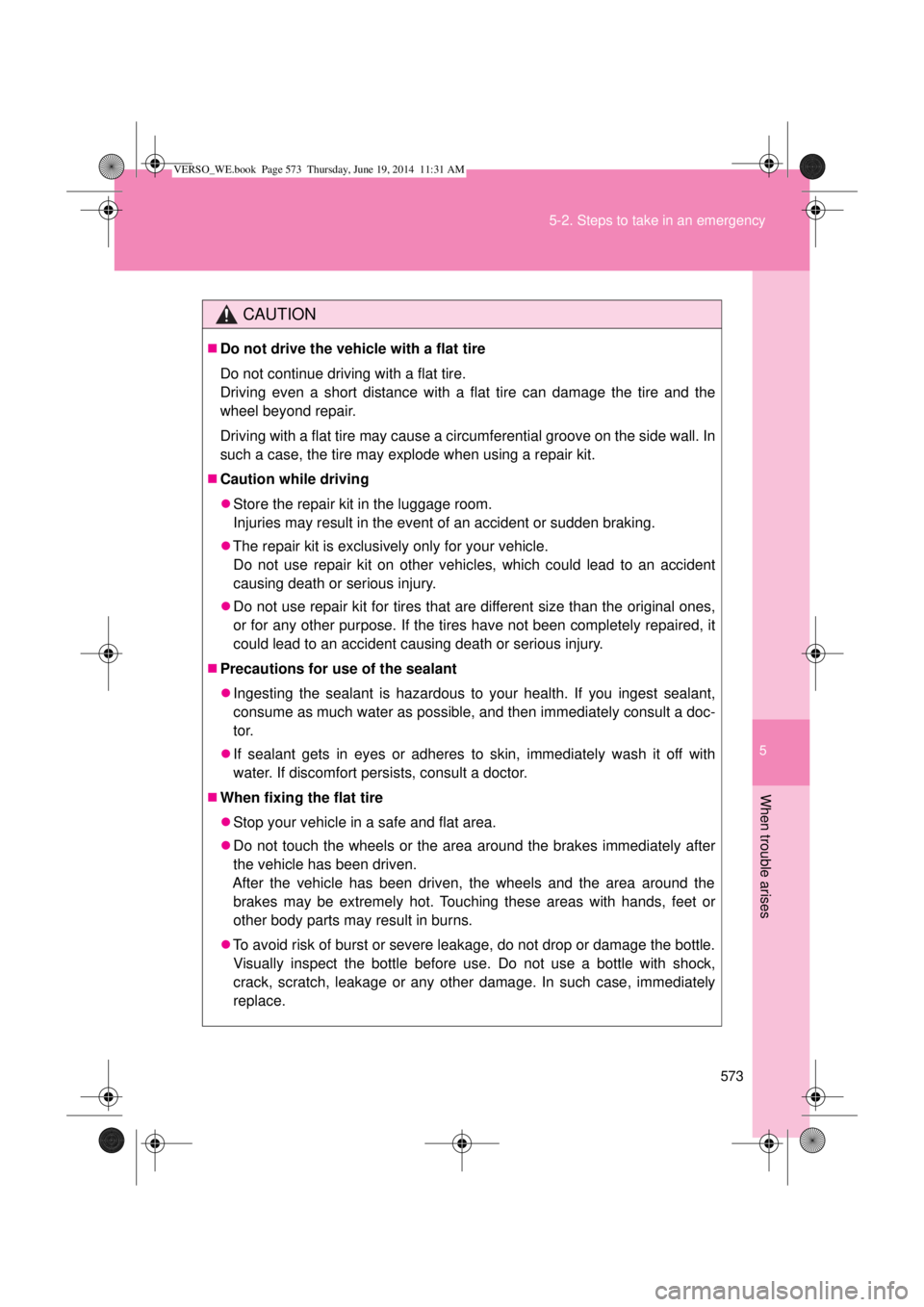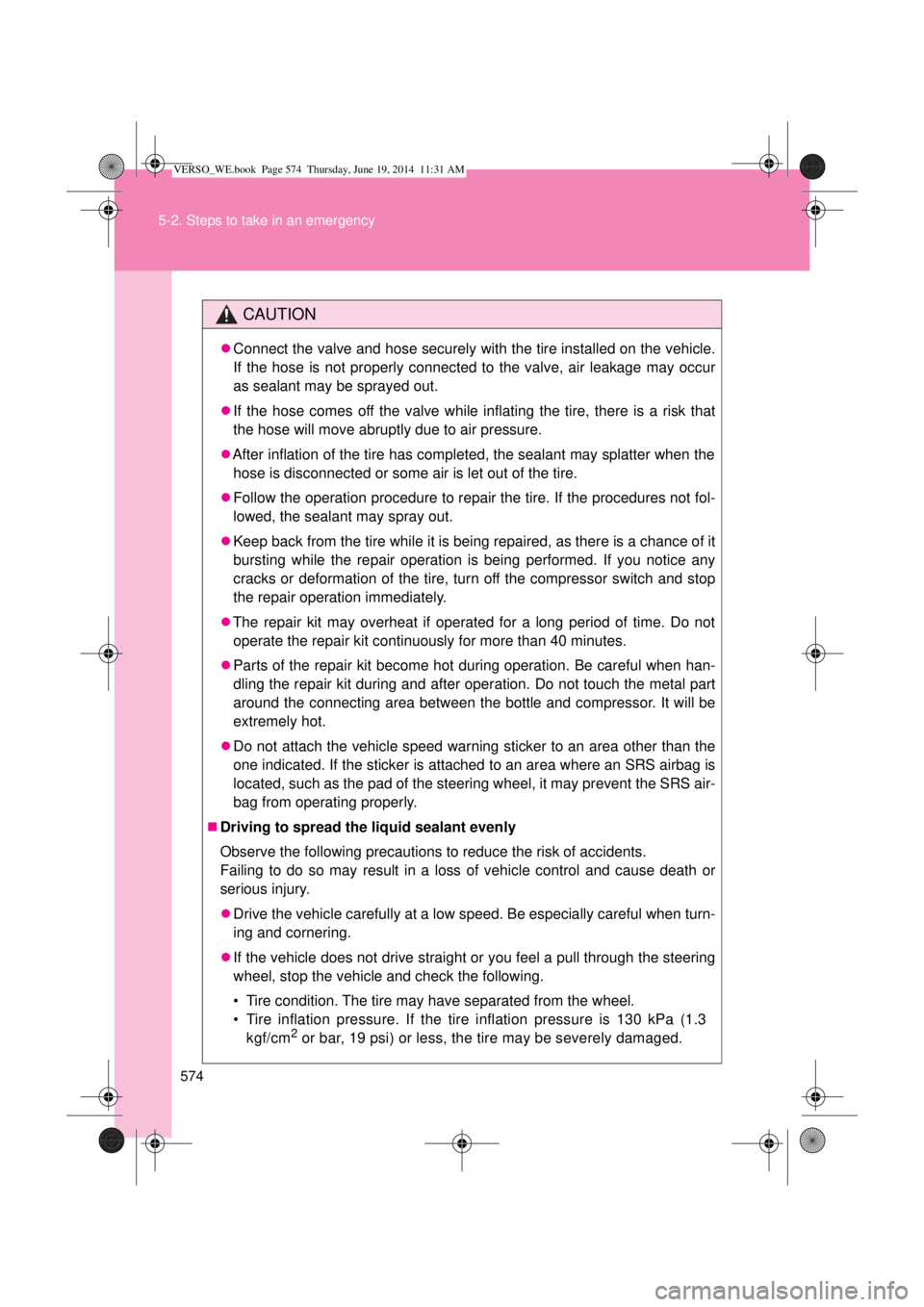Page 571 of 650
5
571 5-2. Steps to take in an emergency
When trouble arises
If the tire is inflated to more than the specified air pressure (type B)
Check that the air pressure indicator shows the specified air pres-
sure.
If the air pressure is under the designated pressure, turn the com-
pressor switch on again and repeat the inflation procedure until the
specified air pressure is reached.
The valve of a tire that has been repaired
After a tire is repaired with the emergency tire puncture repair kit, the valve
should be replaced.
Note for checking the emergency tire puncture repair kit
Check the sealant expiry date occasionally.
The expiry date is shown on the bottle. Do not use sealant whose expiry
date has already passed. Otherwise, repairs conducted using the emer-
gency tire puncture repair kit may not be performed properly.Press the button to let some air out.
VERSO_WE.book Page 571 Thursday, June 19, 2014 11:31 AM
Page 573 of 650

5
573 5-2. Steps to take in an emergency
When trouble arises
CAUTION
Do not drive the vehicle with a flat tire
Do not continue driving with a flat tire.
Driving even a short distance with a flat tire can damage the tire and the
wheel beyond repair.
Driving with a flat tire may cause a circumferential groove on the side wall. In
such a case, the tire may explode when using a repair kit.
Caution while driving
Store the repair kit in the luggage room.
Injuries may result in the event of an accident or sudden braking.
The repair kit is exclusively only for your vehicle.
Do not use repair kit on other vehicles, which could lead to an accident
causing death or serious injury.
Do not use repair kit for tires that are different size than the original ones,
or for any other purpose. If the tires have not been completely repaired, it
could lead to an accident causing death or serious injury.
Precautions for use of the sealant
Ingesting the sealant is hazardous to your health. If you ingest sealant,
consume as much water as possible, and then immediately consult a doc-
tor.
If sealant gets in eyes or adheres to skin, immediately wash it off with
water. If discomfort persists, consult a doctor.
When fixing the flat tire
Stop your vehicle in a safe and flat area.
Do not touch the wheels or the area around the brakes immediately after
the vehicle has been driven.
After the vehicle has been driven, the wheels and the area around the
brakes may be extremely hot. Touching these areas with hands, feet or
other body parts may result in burns.
To avoid risk of burst or severe leakage, do not drop or damage the bottle.
Visually inspect the bottle before use. Do not use a bottle with shock,
crack, scratch, leakage or any other damage. In such case, immediately
replace.
VERSO_WE.book Page 573 Thursday, June 19, 2014 11:31 AM
Page 574 of 650

574 5-2. Steps to take in an emergency
CAUTION
Connect the valve and hose securely with the tire installed on the vehicle.
If the hose is not properly connected to the valve, air leakage may occur
as sealant may be sprayed out.
If the hose comes off the valve while inflating the tire, there is a risk that
the hose will move abruptly due to air pressure.
After inflation of the tire has completed, the sealant may splatter when the
hose is disconnected or some air is let out of the tire.
Follow the operation procedure to repair the tire. If the procedures not fol-
lowed, the sealant may spray out.
Keep back from the tire while it is being repaired, as there is a chance of it
bursting while the repair operation is being performed. If you notice any
cracks or deformation of the tire, turn off the compressor switch and stop
the repair operation immediately.
The repair kit may overheat if operated for a long period of time. Do not
operate the repair kit continuously for more than 40 minutes.
Parts of the repair kit become hot during operation. Be careful when han-
dling the repair kit during and after operation. Do not touch the metal part
around the connecting area between the bottle and compressor. It will be
extremely hot.
Do not attach the vehicle speed warning sticker to an area other than the
one indicated. If the sticker is attached to an area where an SRS airbag is
located, such as the pad of the steering wheel, it may prevent the SRS air-
bag from operating properly.
Driving to spread the liquid sealant evenly
Observe the following precautions to reduce the risk of accidents.
Failing to do so may result in a loss of vehicle control and cause death or
serious injury.
Drive the vehicle carefully at a low speed. Be especially careful when turn-
ing and cornering.
If the vehicle does not drive straight or you feel a pull through the steering
wheel, stop the vehicle and check the following.
• Tire condition. The tire may have separated from the wheel.
• Tire inflation pressure. If the tire inflation pressure is 130 kPa (1.3
kgf/cm
2 or bar, 19 psi) or less, the tire may be severely damaged.
VERSO_WE.book Page 574 Thursday, June 19, 2014 11:31 AM
Page 621 of 650

621 6-1. Specifications
6
Vehicle specifications
Tires and wheels
16 inch tires
Tire size205/60R16 92V,
T145/70D17 106M (compact spare)
1ZR-FAE and
2ZR-FAE engines
Tire inflation pressure
(Recommended cold tire
inflation pressure)Vehicle
speedFront wheel
kPa (kgf/cm
2
or bar, psi)Rear wheel
kPa (kgf/cm2
or bar, psi)
160 km/h
(99 mph) or
less240 (2.4, 35) 230 (2.3, 33)
More than
160 km/h
(99 mph)270 (2.7, 40) 260 (2.6, 38)
1AD-FTV and
1WW-FHV engines
Tire inflation pressure
(Recommended cold tire
inflation pressure)Vehicle
speedFront wheel
kPa (kgf/cm
2
or bar, psi)Rear wheel
kPa (kgf/cm2
or bar, psi)
160 km/h
(99 mph) or
less250 (2.5, 36) 230 (2.3, 33)
More than
160 km/h
(99 mph)280 (2.8, 41) 260 (2.6, 38)
Tire inflation pressure
(compact spare)
(Recommended cold tire
inflation pressure)420 kPa (4.2 kgf/cm
2 or bar, 60 psi)
Wheel size16 6 1/2J,
17 4T (compact spare)
Wheel nut torque 103 N·m (10.5 kgf·m, 76 ft·lbf)
VERSO_WE.book Page 621 Thursday, June 19, 2014 11:31 AM
Page 622 of 650
622 6-1. Specifications
17 inch tires
Tire size215/55R17 94W,
T145/70D17 106M (compact spare)
1ZR-FAE and
2ZR-FAE engines
Tire inflation pressure
(Recommended cold tire
inflation pressure)Vehicle
speedFront wheel
kPa (kgf/cm
2
or bar, psi)Rear wheel
kPa (kgf/cm2
or bar, psi)
190 km/h
(118 mph)
or less240 (2.4, 35) 230 (2.3, 33)
More than
190 km/h
(118 mph)270 (2.7, 40) 260 (2.6, 38)
1AD-FTV, 2AD-FHV and
1WW-FHV engines
Tire inflation pressure
(Recommended cold tire
inflation pressure)Vehicle
speedFront wheel
kPa (kgf/cm
2
or bar, psi)Rear wheel
kPa (kgf/cm2
or bar, psi)
190 km/h
(118 mph)
or less250 (2.5, 36) 230 (2.3, 33)
More than
190 km/h
(118 mph)280 (2.8, 41) 260 (2.6, 38)
Tire inflation pressure
(compact spare)
(Recommended cold tire
inflation pressure)420 kPa (4.2 kgf/cm
2 or bar, 60 psi)
Wheel size17 7J,
17 4T (compact spare)
Wheel nut torque 103 N·m (10.5 kgf·m, 76 ft·lbf)
VERSO_WE.book Page 622 Thursday, June 19, 2014 11:31 AM
Page 623 of 650
623 6-1. Specifications
6
Vehicle specifications
When towing a trailer
Add 20.0 kPa (0.2 kgf/cm
2 or bar, 3 psi) to the recommended tire inflation
pressure, and drive at speeds below 100 km/h (62 mph).
When installing a compact spare tire (vehicles with compact spare tire)
Do not tow if your vehicle has a compact spare tire installed.
VERSO_WE.book Page 623 Thursday, June 19, 2014 11:31 AM
Page 633 of 650
633
6
Vehicle specifications
6-3. Initialization
Items to initialize
*: Diesel engine only
ItemWhen to initializeReference
Engine oil mainte-
nance data
*After changing engine oil P. 428
Tire pressure
warning system
(if equipped)• When rotating the tires on
vehicles with differing front
and rear tire inflation pres-
sures
• When changing tire pressure
(such as when changing trav-
eling speed)
• When changing the tire sizeP. 445
The following item must be initialized for normal system operation in
cases such as after the battery is reconnected, or maintenance is
performed on the vehicle.
VERSO_WE.book Page 633 Thursday, June 19, 2014 11:31 AM
Page 639 of 650

639 Alphabetical index
Display
Multi-information display ....... 239
Trip information ..................... 240
Warning message ................. 523
Do-it-yourself maintenance .... 412
Door courtesy lights
Door courtesy lights .............. 365
Wattage................................. 624
Doors
Back door ................................ 79
Door glasses ......................... 112
Door lock ..................... 42, 64, 73
Double locking system .......... 134
Rear door child protector ........ 75
Side doors ............................... 73
Side mirrors........................... 109
Double locking system............ 134
Driver’s and front passenger’s
seat belt reminder
light ......................................... 517
Driving
Break-in tips .......................... 185
Correct posture ..................... 145
Procedures............................ 182
Winter driving tips ................. 298
Electronic key
If your electronic does not
operate properly ................. 582
Electronic power steering ....... 287
Emergency flashers
Switch ................................... 502
Emergency tire puncture
repair kit ................................. 552
Emergency, in case of
If the electronic key does not
operate properly ................. 582
If the engine will not start ...... 576
If the shift lever cannot be
shifted from “P” ................... 579If the vehicle has discharged
battery ................................ 585
If the warning buzzer
sounds ................................ 514
If the warning light
turns on .............................. 514
If the warning message is
displayed ............................ 523
If you cannot operate back
door opener ........................ 581
If you have a flat tire .... 536, 552
If you lose your keys ............. 580
If you run out of fuel and
the engine stalls ................. 592
If you think something is
wrong.................................. 512
If your vehicle becomes
stuck ................................... 593
If your vehicle has to be
stopped in an emergency ... 595
If your vehicle needs to be
towed .................................. 503
If your vehicle overheats ....... 589
Engine
Accessory mode ................... 202
Compartment ........................ 420
Engine switch................ 196, 200
Hood ..................................... 416
How to start the
engine......................... 196, 200
Identification number ............ 601
If the engine will not start ...... 576
If you run out of fuel and
the engine stalls ................. 592
Ignition switch ............... 196, 200
Overheating .......................... 589
Engine compartment cover .... 423
E
VERSO_WE.book Page 639 Thursday, June 19, 2014 11:31 AM